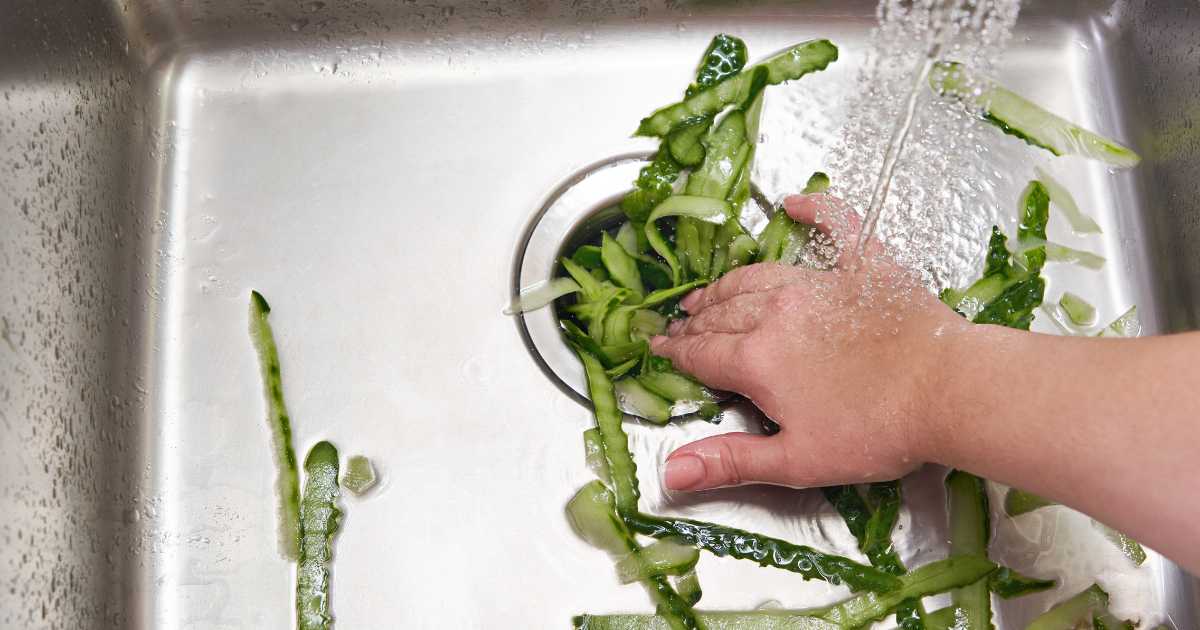A garbage disposal is one of those handy appliances that makes kitchen cleanup faster and easier—but it needs proper care to work its best! Many people don’t realize there are specific dos and don’ts when it comes to using their disposal.
Improper use can lead to costly repairs, clogged drains, and even damage to the unit itself. Here’s a complete guide to keeping your garbage disposal in top shape with six essential tips.
6 Essential Tips for Proper Garbage Disposal Use
Always Use Cold, Running Water
Turning on a steady stream of cold water before, during, and after using your disposal is critical. Start the water before adding any waste, keep it running while the disposal operates, and let it flow for about 15-30 seconds after grinding has stopped.
Cold water helps food scraps move smoothly through the pipes and prevents oils and fats from melting, which aligns with proper waste disposal practices outlined in waste management dumpster rules. When hot water is used, oils can liquefy and then solidify further down the drain, leading to buildup that can cause blockages.

Stick to Cold Water Only to Avoid Clogs
Using cold water is particularly helpful in solidifying fats and oils, which can then be ground up and flushed down the drain in smaller, manageable particles. When fats and oils come into contact with hot water, they stay in a liquid state, which can cause them to coat the insides of your pipes as they cool and solidify, resulting in stubborn blockages. Using cold water helps prevent odors from oils lingering in your pipes, keeping your kitchen smelling fresher
Avoid Overloading the Disposal with Large Quantities
Although the garbage disposal is tough, it’s designed for gradual feeding rather than processing large amounts of food at once. Overloading can cause the blades to jam, the motor to strain, and the disposal to clog.
When disposing of food waste, break large pieces into smaller chunks, and feed them gradually. For example, instead of throwing in an entire half of a fruit or large vegetable scraps, cut them into smaller portions, adding a little at a time. This prevents the motor from overheating and ensures the waste is ground thoroughly. If you have excess waste, you might consider renting a dumpster for a clean-up job.
Fully Grind All Waste and Flush with Extra Water
To keep your disposal and drain clear, make sure the unit grinds all food waste thoroughly. Wait until the grinding sound stops, then let the disposal run for another 30 seconds to ensure everything is fully broken down.
Follow this with a 30-second flush of cold water to ensure that any remaining particles and debris are washed through your pipes. This habit helps prevent clogs caused by partially ground food waste settling in the pipes, reducing the risk of odors and keeping your disposal clear for future use.

Double-Check for Foreign Objects in the Sink
It’s easy to accidentally drop small utensils, jewelry, or other objects into the disposal. These foreign objects can damage the disposal’s blades and even cause it to stop working altogether. Before turning on the disposal, take a moment to check your sink for any items that don’t belong. Remove silverware, small kitchen tools, and any objects that could fall in, as metal or plastic can jam the disposal, requiring expensive repairs or replacements.
Know What Not to Put in the Disposal
Some foods and items are best disposed of in the trash rather than the garbage disposal. Here are the key offenders that should be kept out:
Grease, Oil, and Liquid Fats: These will harden as they cool and stick to pipes, leading to slow drainage and clogs over time. Instead, pour grease and oil into a disposable container, let it solidify, and then throw it in the trash. For larger quantities of such waste, learn what can go in a dumpster rental.
Fibrous or Stringy Vegetables (Celery, Corn Husks, Onion Skins): The fibers can wrap around the disposal blades and reduce grinding effectiveness. These should be composted or thrown away.
Starches and Expandable Foods (Potato Peels, Rice, Pasta): These foods absorb water and can expand, creating a gluey paste that can clog the disposal and pipes. Potato peels, in particular, can turn into a thick sludge that’s hard to wash down.
Coffee Grounds: Though they seem small, coffee grounds accumulate into a dense, sludge-like layer that can stick to the pipes and slow drainage.
Large Animal Bones and Shells: The disposal is not strong enough to grind through hard items like bones and shells, which can damage the blades and jam the unit. Compost or throw these in the trash instead.
Additional Maintenance Tips for a Long-Lasting Disposal:
Regular Cleaning: Every month, refresh your disposal by grinding ice cubes and citrus peels (like lemon or lime). The ice helps sharpen the blades, while the citrus acts as a natural deodorizer, keeping things fresh and clean.
Avoid Chemical Cleaners: Avoid pouring harsh drain cleaners into your disposal, as these can corrode parts of the disposal unit over time. Instead, opt for a mixture of baking soda and vinegar if you need to remove odors or small buildups naturally.
By following these steps, you can help extend your garbage disposal’s life, reduce the likelihood of clogs, and keep your kitchen smelling fresh. And if you have any questions about disposal use or need professional plumbing assistance, don’t hesitate to contact Cabrillo, your trusted Bay Area plumbing, heating, and cooling experts.
Frequently Asked Question
How often should I clean my garbage disposal, and what’s the best way to do it?
For optimal performance and to prevent odors, clean your garbage disposal once a month. An easy way to clean it naturally is by using a handful of ice cubes and a few lemon or orange peels. Run cold water, turn on the disposal, and grind up the ice and citrus.
The ice sharpens the blades and dislodges food particles, while the citrus peels act as a natural deodorizer. For a deeper clean, pour half a cup of baking soda into the disposal, add a cup of vinegar, let it sit for 10 minutes, then flush with hot water.
Can I put eggshells down the disposal?
While some people believe eggshells help sharpen the blades, it’s best to avoid them. The membrane inside eggshells can wrap around the disposal’s blades, reducing their effectiveness.
Ground eggshell fragments can also contribute to a gritty residue that may build up over time, leading to potential clogs. For the health of your disposal, it’s better to dispose of eggshells in the trash or compost.
Is it okay to put small bones, like fish or chicken bones, in the disposal?
Even though small bones won’t necessarily damage your disposal immediately, they put extra strain on the motor and blades, shortening the lifespan of the disposal. Hard bones can wear down the blades and increase the risk of jamming. For any bones, large or small, it’s best to dispose of them in the trash.
Why does my garbage disposal smell bad, and how can I prevent this?
Odors usually result from food particles trapped in the disposal or pipe. Over time, these particles decompose, causing bad smells. To prevent odors, regularly run cold water for a few seconds after each use to clear out any lingering food particles. For occasional deeper cleanings, try grinding citrus peels or using a baking soda and vinegar solution to eliminate odors naturally.
What should I do if I accidentally drop something like a utensil in the disposal?
If a foreign object, such as a spoon or fork, falls into the disposal, immediately turn off the unit to avoid damaging the blades or motor. Unplug the disposal or turn off the circuit breaker for safety, then use tongs or pliers to carefully retrieve the item.
Avoid reaching directly into the disposal with your hands, as even a turned-off disposal can have sharp blades that may cause injury.
Should I use hot or cold water with the garbage disposal?
Always use cold water when running the disposal, as it helps solidify grease and fats, allowing them to be ground up effectively and flushed out.
Hot water, on the other hand, melts fats and oils, which can then coat your pipes and lead to stubborn clogs. You can use hot water occasionally for cleaning purposes, but avoid it during disposal use.
How can I tell if my disposal is jammed, and what should I do about it?
Signs of a jam include humming sounds without grinding or the disposal failing to turn on altogether. To troubleshoot, turn off the unit, unplug it, or switch off the circuit breaker for safety.
Insert an Allen wrench (many disposals have a spot for this under the unit) and gently rotate it back and forth to free the jammed blades. After this, reset the unit by pressing the red button on the bottom if needed. If the problem persists, consider calling a professional to avoid further damage.
Conclusion
A garbage disposal is a powerful, time-saving tool that keeps your kitchen running smoothly, but proper use and maintenance are essential for getting the most out of it.
If you stick to these six simple tips—using cold water, not overloading, grinding waste properly, keeping foreign objects out, and knowing what not to put in—you’ll keep things running smoothly and avoid costly plumbing problems.
Regular maintenance is also key to extending the life of your disposal. Monthly cleanings with ice cubes, citrus peels, or baking soda and vinegar can keep your unit fresh and running efficiently. Steer clear of chemical cleaners, and be cautious with what you put down the disposal to prevent damage and clogs.
